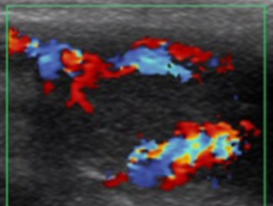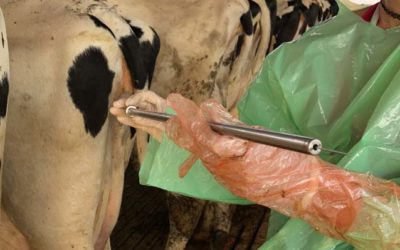Embryo transfer
A way to improve the viability and sustainability of dairy cattle farms
The last two decades have seen a decline in fertility and an increase in milk production. This fertility
decline is associated with genetic progress, such as improvements in nutrition and management,
which have led to a continued increase in milk production. This increase has also been linked to the
incidence of twin calving, which is undesirable in dairy cattle, as it reduces livestock profitability and
animal longevity, and increases the use of antibiotics. One of the most effective ways to improve
dairy cow fertility, especially during warm seasons, or to reduce twin calving and therefore twin
pregnancies, is embryo transfer. This practice drastically reduces the negative effects of decreased
fertility and increased pregnancy losses.
Embryo transfer will allow farmers to focus nulliparous and primiparous cows on the production of
female offspring of high genetic value as replacements, and multiparous cows on milk production.
This will increase the farm’s average lactation number and the price of calves to be sold. Despite all
these benefits, this system is implemented neither in Spain nor Europe. A change in the mentality of
farmers and veterinarians is needed to make this technique routine practice in females that have
given birth more than twice on commercial dairy farms. This technique can only be used on well-
managed farms, where other factors that could affect the process, such as nutrition state or stress,
are controlled.
AREAS OF APPLICATION
Dairy cows
If used with beef cow embryos, it increases the added value of the calf
In the most productive cows, that is, those in their third or more lactations, the pregnancy rate is improved
The number of twin pregnancies is reduced
An experienced technician and a reference in vitro embryo laboratory are required
Slaughterhouse female oocytes may be used for offspring not needed as replacements
It reduces the number of twin pregnancies
DESCRIPTION OF THE TECHNIQUE
The embryo transfer technique is conducted in multiparous cows, especially those having
calved twice or more reared for milk production. The goal is that the more productive yet
least fertile cows become pregnant and are, therefore, not culled.
In addition, this technique of transferring a beef embryo, such as Angus breed, not only
increases the added value of the calves, but also drastically reduces twin pregnancies. It
should be noted that twin pregnancies are one of the most common causes of:
Culling of a producing cow
Increased number of open days
Use of antibiotics postpartum
Miscarriage
Death upon calving of calves and their mothers
STEPS
Fresh embryo preparation
Collect ovaries from the slaughterhouse (Angus or Holstein-Friesian) and transport to the laboratory at 35-37ºC in saline solution
2. Aspirate follicles of 2-8 mm
3. In vitro maturation (IVM) in TCM-199 medium plus 10% FBS (24 h)
4. Oocyte recovery and in vitro fertilization (IVF) (with Angus semen) in TCM-199 medium plus 10% FBS.
5. In vitro culture (IVC) of embryos for 7 days
6. Selection of blastocysts graded excellent
7. Blastocysts placed in a straw and transferred fresh to the farm in a portable incubator at a controlled temperature of 38ºC
Preparation of recipient females
1 Synchronization with the methods used by the farm, preferably progesterone based
2. Transrectal ultrasound to detect follicles when cow is in heat. Administer an ovulation inducer (GnRH, dephereline, hCG)
3. Detect the presence of a corpus luteum by ultrasound at the time of transfer (7 days after oestrus). Eliminate cows experiencing ovulation failure or with a poor quality corpus luteum. Administer an ovulation inducer to promote corpus luteum maintenance
(GnRH, dephereline, hCG)
4. Epidural anaesthesia
5. Clean the vulva using water with iodine
6. Transfer embryos via deep ipsilateral horn transfer into the corpus luteum
7. Diagnose pregnancy on day 21 post embryo transfer
8. Confirm pregnancy 14 days later
VIDEO
MAIN RESULTS
Seasonal fertility study
Winter fertility | Summer fertility | |
Fresh embryos | 49/120 | 43/120a,b |
Vitrified embryos | 30/60 | 26/60a |
Artificial insemination | 45/122 | 35/125b |
Different letters indicate significant differences between groups P<0.05
Comparative study of GnRH vs hCG
Forty-nine (48.3%) of 120 cows became pregnant after embryo transfer: 16 in the GnRH
group (26.7%) and 33 in the hCG group (55%). Taking GnRH-treated cows as reference, the
likelihood of cows treated with hCG becoming pregnant was 3.3 times higher.
NEWS
Special issue in the magazine ANIMALS MDPI on ‘Therapeutics of twin pregnancies in dairy cows’
Special issue on “Therapeutics of twin pregnancies in dairy cattle”.
Third Prize in the IV Special Prize “Carlos Díaz de Pablo” for the best scientific communication of reproduction of the XXIV International Congress ANEMBE of Bovine Medicine 2019
Depherelin increases luteal activity as measured by Doppler ultrasound after follicular puncture to prevent twin pregnancies in bi-ovular cows.
Dissemination to the press
A new insemination technique eliminates double pregnancies in dairy cattle.
RESEARCHERS
Irina Garcia-Ispierto
Irina Garcia-Ispierto holds a PhD from the University of Barcelona (2008). She is currently a contracted professor at the Department of Animal Science at the University of Lleida and head of research of the Animal Reproduction Group at the Agrotecnio Research Centre. Her research focuses on the reproduction of dairy cattle. Her specialities are twin pregnancies, synchronization methods, reproductive ultrasound, and fertility problems. She has also studied infections such as Coxiella burnetti and parasites such as Neospora caninum.
She has published over 100 articles in indexed journals and has taken part in over 100 conferences, both national and international. She has participated in symposiums organized by companies such as ECUPHAR and Ceva and has written several articles in general interest magazines.
She is the principal investigator of numerous contracts with pharmaceutical companies and dairy cattle farms in the Segrià area, and the principal investigator of an SGR group of the Catalan Government, in addition to a Demonstration project of the Catalan Government. She is currently the editor of the journal Animals, animal reproduction section, and a reviewer for several journals such as Reproduction in Domestic Animals, Theriogenology, and Journal of Dairy Science.
USEFUL LINKS
Articles in scientific journals
López-Gatius, Fernando i Garcia-Ispierto, Irina. 2020. Tranfer of a single embryo versus drainage of subordinate follicles to prevent twin pregnàncies in dairy cows. Why not both? Journal of Reproduction and Development, Advanced Epub April 7, 2020.
López-Gatius, Fernando; Garcia-Isperto, Irina; Serrano-Pérez, Beatriz; Balogh, Orsolya G.; Gábor, György i Hunter, Ronald H. F. 2019. Luteal activity following follicular drainage of subordinate follicles for twin pregnancy prevention in bi-ovular dairy cows. Research in Veterinary Science, 124: 439-443.
Articles in professional journals
Garcia-Ispierto, Irina. 2020. Prevención de las gestaciones gemelares en vacuno lechero: un camino hacia la innovación. Albéitar, 234: 4-6.




